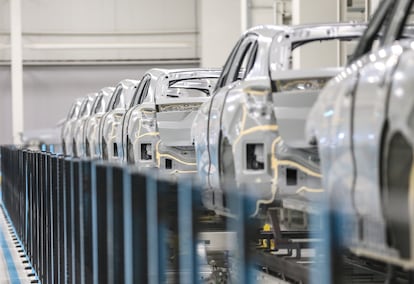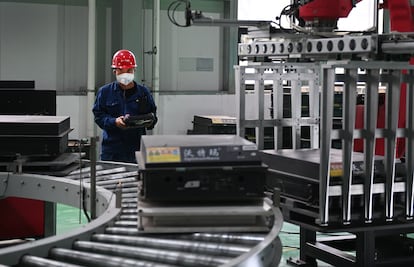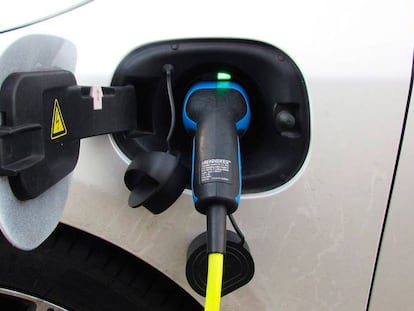The four main obstacles facing electric cars
The European Union, the U.S. and China are committed to putting tens of millions of EVs into circulation in the coming years, but there are serious industrial challenges to fulfilling that plan

It is increasingly common to see an electric vehicle (EV) driving quietly through the streets. EV sales have increased, even within the eco-luxury market, with electric cars becoming a viable option for more and more people. Today, almost all automotive manufacturers have stakes in the future of EVs. What’s more, the vehicles are promoted by authorities as a way to address climate change and curb city pollution. The European Union wants at least 30 million electric cars on the roads by 2030. By the same date, the United States is aiming for half of passenger cars sold in the country to be electric, while China has set a target of 40%.
However, the mass adoption of EVs still faces major obstacles. While the high cost of EVs, the lack of a charging infrastructure and the car’s limited autonomy are often cited as the biggest stumbling blocks, there are other challenges — stemming from how EVs are manufactured — that are also making it difficult for them to take over the roads.
Graphite
In the lithium-ion batteries of electric cars, the negative pole is made of graphite — one of the forms in which carbon is found in nature. It is the only material that is used for this purpose. “Carbon is a material that doesn’t seem very critical. It is very abundant in the Earth’s crust,” explains Belén Sotillo, a Spanish researcher at the Complutense University of Madrid in the Department of Materials Physics. “The problem with batteries is that the graphite that is incorporated has to be processed. And most of the processing plants are in China.” That’s why the European Union has included graphite on its list of critical materials, along with lithium, cobalt, nickel and manganese, which are also components of an EV battery.
Graphite is also the heaviest material in a lithium-ion battery. Its weight varies between 100 and 220 pounds, according to the consultancy firm Kearney. This means that for every 10 million electric cars manufactured, between 500,000 and one million tons of graphite are needed. And currently the global production of graphite — for all its uses — only has the capacity to process one million tons.
Sotillo points out that the search is on for ways to scale up production, but that achieving such a feat is very difficult. Another option is to replace graphite, but that’s not easy either. “Once we have verified that there is an alternative and that it works well, we would have to build the industry,” explains the researcher. “And that is often difficult. You have to move the whole [EV] industry to the new materials.”
Lithium
EV batteries are made of lithium, which, unlike graphite, is found in very small quantities. “Lithium is an element that is not very abundant in the Earth’s crust, so the amount of material that can be obtained to make electric cars is limited,” says Sotillo.
Geoscientist Hannah Ritchie, from the University of Oxford in the United Kingdom, crunched the numbers. It is estimated that there are 88 million tons of lithium on Earth, but only 22 million of them are extractable. According to Ritchie, with these reserves, 2.8 billion electric batteries can be manufactured. It is difficult to know how many EVs there are in the world, but some estimates point to a figure of around 1.4 billion. This does not leave room for many more. What’s more, lithium has other uses, meaning the reserves would not solely be used for EVs.
“The other problem with lithium is that it is an element that tends to be very reactive. Once you have used up the battery, it is very difficult to recover it,” explains Sotillo, who says that research is also underway into possible replacements. “Sodium or potassium, in a battery technology similar to lithium, are elements that would have a lower capacity to store energy, but are more easily recoverable and are more abundant.”

Battery recycling
It’s also important to keep in mind that an EV battery occupies the car’s entire chassis. And it only lasts about 10 years. When the time comes to change it, the recycling odyssey begins. Félix Antonio López, a researcher at Spain’s National Research Council (CSIC), points out a key fact: in a recycling plant, dismantling batteries is done by hand, as there are still no automated processes.
“The problems are in the recycling of the internal battery,” says López. Inside that battery, there are modules, made up of cells and batteries. “Those batteries are crushed. And then separation operations are carried out, fundamentally aimed at separating plastics and copper. But this process is not perfect. And the result is what we know as black mass.” This material is named so due to the dominance of the black graphite, but it also contains nickel, cobalt, manganese (from the cathode), as well as lithium, phosphorus and fluorine (present in the battery electrolyte). Recovering those elements is not easy, and it is also a costly process due to the lack of automation. For now, all black mass is sent to China for recycling.
Scaling up recycling is difficult, says López. The researcher calculates that there may be a productive technology — which can be transferred to companies — within five or six years. From there, it would have to be pushed to an industrial scale, which also takes time.
Energy supply
Mass adoption of electric cars will also place greater demands on the electrical grid. In this scenario, Antonio Gómez Expósito, a professor in the Department of Electrical Engineering at the University of Seville in Spain, says it is important to differentiate between two factors: energy, which has to be produced in power plants, and power, which represents the speed at which electricity is delivered.
“In Spain, there is no significant problem in terms of energy production,” says Gómez. Indeed, at night, the productivity of some thermal and nuclear power plants is reduced because they are not necessary. In other words, there is infrastructure to produce more energy than the country consumes.
The difficulty lies with the power of the electrical network. “If everyone charges their car at peak consumption in the afternoon, as would be logical in principle, there would be a big problem, both in the transportation network and in the distribution network,” says Gómez. “To avoid this, the idea is to encourage cars to charge overnight.”
Even so, in a scenario with millions of electric cars, one would expect problems in the distribution network, which involves medium and low voltage. When electricity is generated in a power plant, it is sent to a substation at high voltage and, from there, it goes to energy transformation centers at medium voltage, which distribute electricity via low voltage wiring to homes and businesses.
“A transformation center can typically serve between 100 and 300 customers. If, of those 300 customers, everyone who had an EV charged the vehicle at the same time — even if they did so at night — the low-voltage distribution network that reaches those blocks of apartments would have to be reinforced,” explains Gómez. And this would be a job that would have to be done at the local level, in cities and neighborhoods.
Coordinating the large-scale charging of EVs and upgrading part of the electrical grid are two other obstacles to the mass adoption of electric cars. All these difficulties will become apparent over time, as EV adoption becomes more widespread.
Sign up for our weekly newsletter to get more English-language news coverage from EL PAÍS USA Edition









































